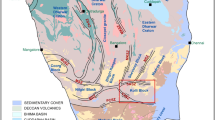Abstract
A white clay from the Jatoba talc mine, Castro, Paraná, Brazil, is shown by chemical analysis, X-ray and electron diffraction, and by thermal analysis to be essentially pure antigorite in the strict sense of the term. Single crystal electron diffraction patterns give various values for the long a parameter, with 43·5 Å perhaps the most commonly occurring, b = 9·25 Å, d(001) = 7·25 Å. X-ray powder diffraction gives d(001) = 7·26 Å and b = 9·23 A. Electron micrographs show irregular platy and lath-like crystals of about 0·5–2 µ size with large development of (001) planes and with b in the direction of elongation. Other crystals are observed with very unusual forms, some having holes through them. They show mainly 0kl diffraction patterns and lie with the basal (001) planes normal to the stage of the instrument. The chemical analysis agrees closely with the ideal serpentine composition and the differential thermal analysis curve is consistent with antigorite.
Résumé
On démontre au moyen de l’analyse chimique, des diffractions de rayons X et d’électrons, et de l’analyse thermique, qu’une argile blanche provenant de la mine de talc Jatoba, Castro, Paraná, Brésil, est une antigorite essentiellement pure, au sens strict du terme. Des diagrammes de diffraction électronique de cristaux uniques fournissent pour le paramètre de plus grand allongement a, des valeurs variables parmi lesquelles 43,5 A est peut être la plus couramment rencontrée; b = 9,25 Å et d(001) = 7,25 Å. La diffraction des rayons X sur poudre donne d(001) = 7,26 Å et b = 9,23 Å. Les micrographies électroniques montrent des cristaux irréguliers plats en forme de lattes d’environ 0,5 à 2 microns, avec un grand développement des plans (001), et b dans la direction de l’allongement. On observe d’autres cristaux d’une forme très inhabituelle, certains d’entre eux présentent-des perforations. Ils donnent principalement des diagrammes de diffraction 0kl et ont les plans basaux (001) dirigés normalement au plan de référence de l’instrument. L’analyse chimique est en très bon accord avec la composition idéale de la serpentine, et la courbe d’analyse thermique différentielle est compatible avec l’antigorite.
Kurzreferat
Ein weisser Ton aus der Jatoba Talkgrube, Castro, Paraná, Brasil wird mittels chemischer Analyse, Röntgen —und Elektronen—beugung, sowie mittels thermischer Analyse als im wesentlichen reiner Antigorit, im wahren Sinne des Wortes, erkannt. Einzelne Kristallbeugungsbilder geben verschiedene Werte für den langen a Parameter, wobei 43,5 Å der am häufigsten vorkommende Wert ist, b = 9,25 Å, d(001) = 7,25 Å. Röntgenpulverbeugung gibt d(001) = 7,26 Å und b = 9,23 Å. Elektronenmikrographien zeigen unregelmässige plättchen—und stabförmige Kristalle von etwa 0,5–2 Mikron Grösse mit weiter Entwicklung der (001) Flächen und mit b in der Längsstreckung. Andere Kristalle mit sehr ungewöhnlichen Formen werden beobachtet, manche mit Durchlochungen. Sie zeigen meist 0kl Beugungsbilder und liegen mit den Basisflächen (001) senkrecht zu dem Gerätetisch. Die chemische Analyse stimmt eng mit der idealen Serpentinzusammensetzung überein und die thermische Analysenkurve steht im Einklang mit Antigorit.
Резюме
Методами химического анализа, рентгенографии, дифракции электронов и терми-ческого анализа установлено, что белая глина из талькового месторождения Джатоба (Паранá, Бразилия), представляет собой почти чистый антигорит в строгом смысле слова. По данным дифракции электронов от монокристаллов определены различные значения для большого параметра а; его наиболее часто встречающееся значение равно 43,5 Å, b = 9,25 Å, d(001) = 7,25 Å. Данные рентгеновских порошкограмм приводят к значениям d(001) = 7,26 Å и b = 9,23 Å. На электронномикроскопических снимках видны кристаллы-пластинки неправиль-ной формы и ленты (0,5–2 мк) с сильно развитыми гранями (001), вытянутые по b. Наблюдались также кристаллы весьма необычной формы, частью со сквозными отверстиями. Подобные кристаллы давали, главным образом, дифракционные картины с набором рефлексов (0kl) и ориентировались базальной плоскостью (001) перпендикулярно препаратодержателю прибора. Данные химического анализа хорошо согласуются с формулой серпентина идеального состава, а кривая ДТА характерна для антигорита.
Similar content being viewed by others
References
Aruja, E. (1945) X-ray study of the crystal structure of antigorite: Mineral. Mag. 27, 65–74.
Brindley, G. W., Comer, J. J., Uyeda, R. and Zussman, J. (1958) Electron-optical observations with crystals of antigorite: Acta Crystallog. 11, 99–102.
Caillère, S. and Hénin, S. (1957) The chlorite and serpentine minerals. In The Differential Thermal Investigation ot clays (R. C. Mackenzie, Editor), Mineralogical Society, London. Chap. VIII. pp. 221–224.
Hess, H. H., Smith, R. J. and Dengo, G. (1952) Antigorite from the vicinity of Caracas, Venezuela: Am. Mineralogist 37, 68–75.
Kunze, G. (1956) Die gewellte Struktur des Antigorits —I: Z. Kristallog. 108, 82–107.
Kunze, G. (1957) Die gewellte Struktur des Antigorits: Fortschr. Miner. 35, 46–48.
Kunze, G. (1958) Die gewellte Struktur des Antigorits—II: Z. Kristallog. 110, 282–320.
Kunze, G. (1961) Antigorit. Strukturtheoretische Grundlagen und ihre praktische Bedeutung für die weitere Serpentin-Forschung: Fortschr. Miner. 39, 206–324.
Trein, E. (1967) Geologia de folhade Contenda, Paraná. (Geology of the Contenda Sheet), no. 27, p. 9. Boletim da Universidade do Parana, Geologiá.
Whittaker, E. J. W. and Zussman, J. (1956) The characterization of serpentine nhnerals by X-ray diffraction: Mineral. Mag. 31, 107–126.
Zussman, J. (1954) Investigation of the crystal structure of antigorites: Mineral. Mag. 30, 498–512.
Zussman, J., Brindley, G. W. and Comer, J. J. (1957) Electron diffraction studies of serpentine minerals: Am. Mineralogist 42, 133–153.
Author information
Authors and Affiliations
Rights and permissions
About this article
Cite this article
Brindley, G.W., Santos, P. Antigorite—Its Occurrence As a Clay Mineral. Clays Clay Miner. 19, 187–191 (1971). https://doi.org/10.1346/CCMN.1971.0190307
Received:
Published:
Issue Date:
DOI: https://doi.org/10.1346/CCMN.1971.0190307




